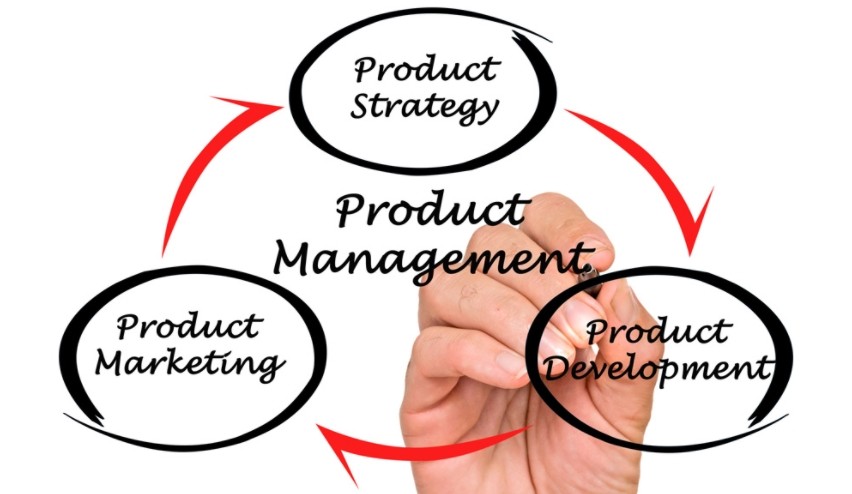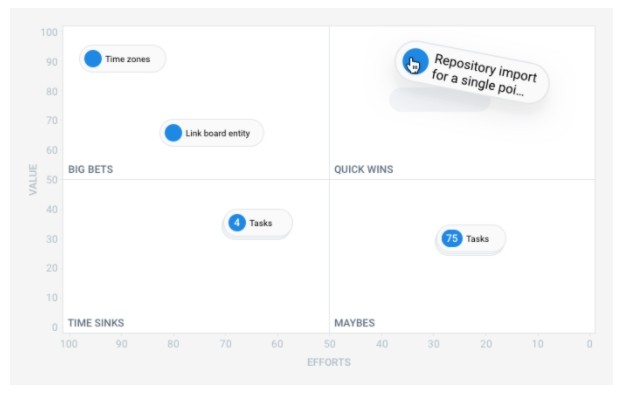Where does a quality strategy begin and why is it needed in product management?
Product management is becoming an essential part of the operation of most companies. However, for some startups and even large teams, the process of managing a product remains an incomprehensible phenomenon.
The product management process consists of several stages, where one of the main and fundamental ones is the definition of a strategy and its competent use throughout the entire product life cycle.

Product management is a discipline aimed at planning, developing and putting a product or service on the market. Successful product management goes beyond development, marketing, promotion, or sales. This is a set of efforts of the whole team, which leads to success. The role of “first mover” in this case is assigned to the product manager.
')

Product management is the process of creating and supporting a product, which includes the development and marketing part. These parts are related to the product from its concept to release.
Product development consists of a definition of strategy and concept and production directly. Marketing issues - customer service and product sales.
If we imagine that the product management process is a staircase, then the product concept is at the bottom, and the sale to the customer is at the very top of the staircase. Product strategy must be present at each stage.

Each manager must go through these steps in order to move forward and achieve his ultimate goal.
This beginning began, without which the future life of the product is not possible. The stage of preparation of the strategy takes place with simultaneous research and analysis of the market.
Market research includes information about customers and competitors. Here, to generate data, you can use both qualitative and quantitative analysis. You can use any source to search for additional information: websites, social networks, industry press, open information of partners, opinions of influential persons and opinion leaders, experts, books for product management. Also useful will be some of the methods of market research, such as A / B testing, customer analysis, customer interviews, focus groups, etc.
A strategy is a set of activities for the gradual development of a new product or the improvement of the results of an existing one. This is a marketing plan that may include the brand architecture and its identity, customer service, business model, design, functions, release, market niche, pricing, promotion, risks, and so on. About this below.
When there is a complete understanding of the strategy and the necessary analysis is made, you can begin to develop. At this stage of the product life cycle, its design, design and testing take place. Development brings new products and updates to the market.
The product launch ensures its appearance on the market and includes an operational and marketing component. This is a peculiar moment of truth for all team members, since the product is ready for purchase by customers.
Product launch planning takes place in parallel with development and may include sales planning, promotion issues, customer support, pricing, risk management, and monitoring.
Branding determines the value and individuality of the product, which must "settle" in the minds of customers. This process includes such marketing elements as concept definition, naming, brand identity, visual creation, brand awareness, positioning, brand loyalty, and more.
Promotion includes a communication strategy to increase product awareness and awareness. Promotional activities also accelerate customer interest and enthusiasm.
The main goal of any advertising campaign is to generate demand for products in support of sales.
Therefore, product managers must have sufficient experience and marketing skills to work with advertising, PR, communications and sales.
Working with clients is a business approach focused on customer satisfaction. It consists of any interaction with the client and their support.
Pricing is about setting a specific price that aims to maximize long-term profit. It depends on supply and demand, market competition, behavioral factors, rules and current standards.
Product managers should take care of how and in what form the product will reach potential customers. This is related to marketing channels and may include retail sales, affiliate campaigns, direct marketing, dealer networks, sales agents, resellers and other options.
This is the final stage of product cycle management and customer relationship management. This is the process of closing a deal and a commercial agreement.
This is a post-sales stage. Customer feedback plays a key role in improving the product features offered. It provides product managers with valuable information and suggestions and helps identify problems that they did not know about.
However, let us return to the very first stage in the management of the product, which determines its entire fate.
Developing a strategy is not half an hour of product manager time or the result of a brief meeting with team members. A deep and well thought out strategy is a solid work.
The strategic thinking of a product manager is a kind of icebreaker that can pass through any barriers and achieve any complex goal. Those who believe that steep results can be achieved without any strategy will hardly be interesting to read further.
Any strategy is aimed at meeting the interests of stakeholders and achieving the goals of different levels. It should contain a clear understanding of the product’s values for all team members.
Product strategy is the basis of its life cycle. If you want to build a reliable and successful strategy for your product, pay attention to its aspects: vision, goals, ideas and initiatives.
When determining the product's product strategy, be sure to answer the following questions:

Here is a brief example of a non-development product strategy abstract for a general understanding:
In working with the strategy today, we cannot do without the help of professional services and tools. The Hygger.io platform helps product managers plan their roadmap , manage backlog, and prioritize tasks.

In conclusion, I would like to note once again that an effective product strategy is not random actions, but serious work. This is the first step in the vertical ladder of the product management process. And this step should be confident and durable. Pay attention to this and your competent strategy will certainly lead to a successful release of the product.
The product management process consists of several stages, where one of the main and fundamental ones is the definition of a strategy and its competent use throughout the entire product life cycle.

What is product management?
Product management is a discipline aimed at planning, developing and putting a product or service on the market. Successful product management goes beyond development, marketing, promotion, or sales. This is a set of efforts of the whole team, which leads to success. The role of “first mover” in this case is assigned to the product manager.
')

The main stages of the product management process
Product management is the process of creating and supporting a product, which includes the development and marketing part. These parts are related to the product from its concept to release.
Product development consists of a definition of strategy and concept and production directly. Marketing issues - customer service and product sales.
If we imagine that the product management process is a staircase, then the product concept is at the bottom, and the sale to the customer is at the very top of the staircase. Product strategy must be present at each stage.

Each manager must go through these steps in order to move forward and achieve his ultimate goal.
1. Definition of product strategy
This beginning began, without which the future life of the product is not possible. The stage of preparation of the strategy takes place with simultaneous research and analysis of the market.
Market research includes information about customers and competitors. Here, to generate data, you can use both qualitative and quantitative analysis. You can use any source to search for additional information: websites, social networks, industry press, open information of partners, opinions of influential persons and opinion leaders, experts, books for product management. Also useful will be some of the methods of market research, such as A / B testing, customer analysis, customer interviews, focus groups, etc.
A strategy is a set of activities for the gradual development of a new product or the improvement of the results of an existing one. This is a marketing plan that may include the brand architecture and its identity, customer service, business model, design, functions, release, market niche, pricing, promotion, risks, and so on. About this below.
2. Product Development
When there is a complete understanding of the strategy and the necessary analysis is made, you can begin to develop. At this stage of the product life cycle, its design, design and testing take place. Development brings new products and updates to the market.
3. Product launch
The product launch ensures its appearance on the market and includes an operational and marketing component. This is a peculiar moment of truth for all team members, since the product is ready for purchase by customers.
Product launch planning takes place in parallel with development and may include sales planning, promotion issues, customer support, pricing, risk management, and monitoring.
4. Branding
Branding determines the value and individuality of the product, which must "settle" in the minds of customers. This process includes such marketing elements as concept definition, naming, brand identity, visual creation, brand awareness, positioning, brand loyalty, and more.
5. Product Promotion
Promotion includes a communication strategy to increase product awareness and awareness. Promotional activities also accelerate customer interest and enthusiasm.
The main goal of any advertising campaign is to generate demand for products in support of sales.
Therefore, product managers must have sufficient experience and marketing skills to work with advertising, PR, communications and sales.
6. Work with clients
Working with clients is a business approach focused on customer satisfaction. It consists of any interaction with the client and their support.
7. Pricing policy
Pricing is about setting a specific price that aims to maximize long-term profit. It depends on supply and demand, market competition, behavioral factors, rules and current standards.
8. Product Release
Product managers should take care of how and in what form the product will reach potential customers. This is related to marketing channels and may include retail sales, affiliate campaigns, direct marketing, dealer networks, sales agents, resellers and other options.
9. Sales
This is the final stage of product cycle management and customer relationship management. This is the process of closing a deal and a commercial agreement.
10. Work with customer feedback
This is a post-sales stage. Customer feedback plays a key role in improving the product features offered. It provides product managers with valuable information and suggestions and helps identify problems that they did not know about.
However, let us return to the very first stage in the management of the product, which determines its entire fate.
What is a good strategy and why is it a product manager?
Developing a strategy is not half an hour of product manager time or the result of a brief meeting with team members. A deep and well thought out strategy is a solid work.
The strategic thinking of a product manager is a kind of icebreaker that can pass through any barriers and achieve any complex goal. Those who believe that steep results can be achieved without any strategy will hardly be interesting to read further.
“A strategy without tactics is the slowest path to victory, a tactic without strategy is the noise before defeat.” Sun Tsu, an ancient Chinese military strategistIn general terms, any strategy determines the direction of the product and what the owners of the product want to achieve. An effective strategy allows all team members to focus on the work that matters most here and now. Product managers provide a ready-made strategy to the team and share what needs to be done.
What is the main goal of the product strategy?
Any strategy is aimed at meeting the interests of stakeholders and achieving the goals of different levels. It should contain a clear understanding of the product’s values for all team members.
Product strategy is the basis of its life cycle. If you want to build a reliable and successful strategy for your product, pay attention to its aspects: vision, goals, ideas and initiatives.
- The product vision consists of market research, positioning, target audience, competitor analysis, etc. It describes customer needs and how you plan to meet their needs.
- The objectives of the product must be clear, relevant, measurable and time-definable. They can help product managers establish what they want to accomplish in a certain period of time. For example, enter the Asian market, increase income by 25%, etc.
- Product ideas and initiatives are efforts that must be implemented to achieve strategic goals. For example, improved user interface, optimized performance, enhanced capabilities for US customers, and more.
"Strategy without a process is nothing more than a wish list." Robert Filek
5 key questions for the product manager to help determine strategy
When determining the product's product strategy, be sure to answer the following questions:
- What market and customers do you sell your product? This may seem trivial, but the correct definition of the target audience is the first step to success.
- What is your product really? Describe for yourself what you are selling, and think about how customers will perceive your product compared to competitors. Identify unique features.
- How would you rate your product? It's time to think about the intended value of the product and pricing model.
- What are the values for your customers? Think about real customer problems that can be solved with your product.
- What sales channels will you choose for your product? Describe how you will sell and promote your product in the market.

A simple example of a product strategy.
Here is a brief example of a non-development product strategy abstract for a general understanding:
- Suppose we develop high-quality plastic windows and doors for local outlets.
- Our customers are small businesses: shops and cafes that want high-quality architectural standards and high-quality goods. They are interested in materials that are safe and environmentally friendly for their customers.
- We sell our products through retail channels.
- Our products are priced per item. They are "high quality" architectural solutions.
In working with the strategy today, we cannot do without the help of professional services and tools. The Hygger.io platform helps product managers plan their roadmap , manage backlog, and prioritize tasks.
- A roadmap or product development plan (product roadmap) visualizes all product ideas and initiatives and helps to share them with team members and all interested parties.
- Backlog management helps streamline ideas and correctly plan iterations. The platform’s proposed Value and Effort parameters, as well as the Backlog Priority Chart visualization tool, help to cope with the prioritization of each idea, identifying important and less important tasks.

In conclusion, I would like to note once again that an effective product strategy is not random actions, but serious work. This is the first step in the vertical ladder of the product management process. And this step should be confident and durable. Pay attention to this and your competent strategy will certainly lead to a successful release of the product.
Source: https://habr.com/ru/post/353164/
All Articles